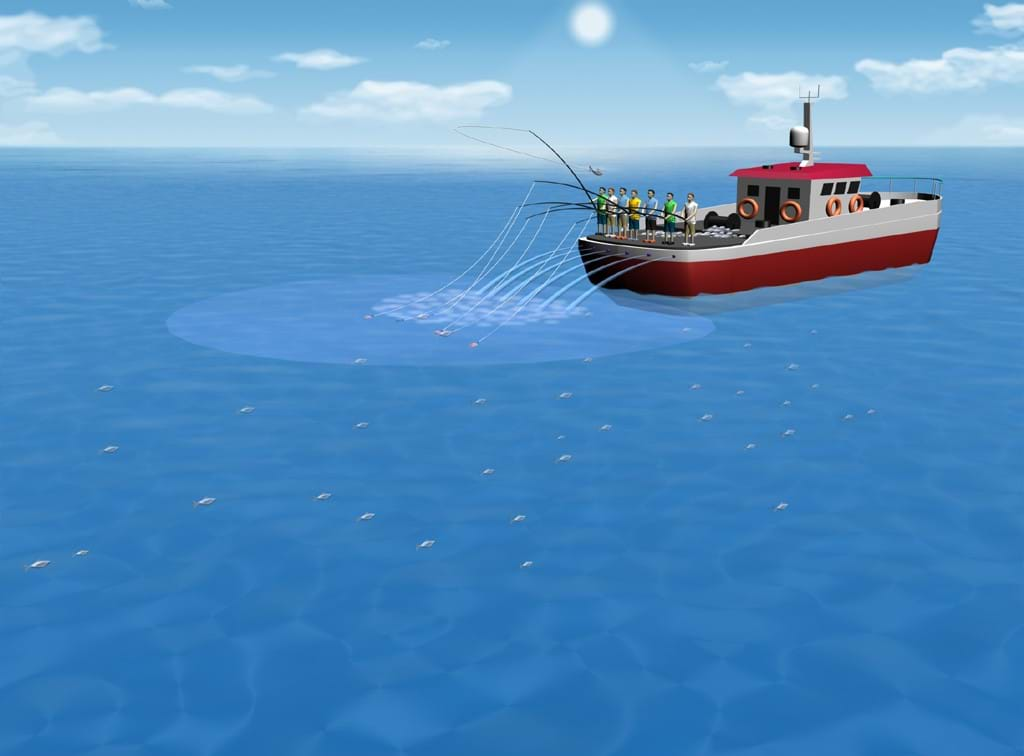Pole and Line
Alternative names
-
- Line fishing
Summary
This is a basic rod and line fishery using barbless hooks and live bait. One of the main fisheries using pole and line fishing is the tuna fishery in tropical waters. The tuna are attracted around the vessel by bait fish that are carried by the vessel and thrown into the sea to attract the shoal close to the boat.
The crew, sometimes as many as 25, cast their rods and barbless hooks into the water, the are attracted to the shiny lure and hook, once hooked the fisherman swings the line overhead and lands the tuna on the vessel deck where the fish releases itself from the barbless hook. The fisherman carries on fishing and casts his rod again while the fish are guided down into the vessels fishroom.

Environmental impact
This is an extremely environmentally friendly way of fishing. It is very much a targeted fishery with no by-catch, and even if there was it could easily be released still alive. It is done at surface level so no seabed impact at all.
The only possible concerns would be with the catching of the bait fish that is used to attract the tuna. There is the possibility of overfishing of vulnerable species on inshore grounds.
Other information
It can be a fairly basic type of fishing, with a minimum of gear. The ‘pole’ consists of a long rod, originally of wood but nowadays more often made of lightweight fibreglass. Attached to this is a short length (similar in length to the pole) of strong line with a barbless hook at the end. This hook will have a simple lure on it, a shiny metal strip or a piece of feather to attract and tempt the tuna to bite.
Combining their experience with modern technology, the skipper will locate a school of tuna, or any other target species.
They will then attract the fish close to the boat by scattering some form of small bait fish, such as sardines or pilchard, around the boat as bait. This is called ‘chumming’ and is done in conjunction with spraying water on the surface to create the illusion that there is a large shoal of small bait fish just below the surface. This will then send the tuna into a feeding frenzy and they will go for anything shiny that they see, such as a barbless hook.
There will be several fishermen, each with a pole, casting their lines into the feeding frenzy at the same time. Once a fish is hooked it is flicked up, over their heads, to land on the deck behind them. Once the strain comes off the line, the fish releases itself from the barbless hook and the fisherman again casts his line into the shoal of fish. The crew will continue to through bait fish into the water to try to keep the shoal feeding around the boat. Once the feeding frenzy ceases, the fish will be stowed below decks on ice or into chilled seawater tanks to keep them in prime condition, and the skipper will try to line up another shoal. This is usually a daily fishing operation to allow the vessel to take onboard fresh baitfish before sailing each day and to land the tuna in prime condition each day.
Documents
-
Responsible Sourcing Guide - Tuna
-
The Promotion of Pole-and-Line Tuna Fishing in the Pacific Islands - Emerging Issues and Lessons Learned
-
Yellowfin tuna - A Global and UK supply chain analysis
Gear classification
Main target species (UK)
-
- Blue Fin Tuna
- Tuna
- Yellow Fin Tuna
Possible bycatch
-
- Very little bycatch